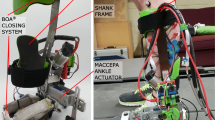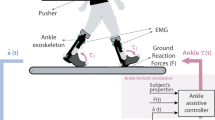Abstract
Gait disabilities empowered intensive research on the field of human-robot interaction to promote effective gait rehabilitation. Assist-as-needed strategies are becoming prominent, appealing to the users’ participation in their rehabilitation therapy. This study proposes and assesses the biomechanical effects of an adaptive impedance control strategy that innovatively allows adaptability in interaction-based stiffness and gait trajectory towards a fully assist-as-needed therapy. By modulating the interaction-based stiffness per gait phase, we hypothesize that the strategy appeals to a symbiotic human-orthotic cooperation, augmenting the user’s muscular activity. The interaction stiffness was estimated by modelling the human-orthosis interaction torque vs angle curve with a linear regression model. The strategy also allows for real-time trajectory adaptations at different gait phases to fulfil the users’ needs. The biomechanical assessment of the impedance-controlled ankle orthosis involved eight healthy volunteers walking at 1.0 and 1.6 km/h. The results revealed a stronger muscular activation regarding the non-assisted leg for the gastrocnemius lateralis (increment ratio ≥ 1.0 for both gait speeds) and for the tibialis anterior muscle (increment ratio ≥ 1.0 for 1.6 km/h). The strategy guided users successfully on a healthy gait pattern while allowing deviations (median error < 5.0°) given the users’ intention weighted by interaction stiffness. Findings showed the relevance for adapting gait trajectory as users prefer higher trajectories as the speed increases. No significant temporal variations or neither knee angular compensations were observed (p value ≥0.11). Overall results support that this strategy may be applied for intensity-adapted gait training, allowing different human-robot compliant levels.
Similar content being viewed by others
Data Availability
Not applicable.
References
Mikolajczyk, T., Ciobanu, I., Badea, D.I., Iliescu, A., Pizzamiglio, S., Schauer, T., Seel, T., Seiciu, P.L., Turner, D.L., Berteanu, M.: Advanced technology for gait rehabilitation: an overview. Adv. Mech. Eng. 10, 1–19 (2018). https://doi.org/10.1177/1687814018783627
Meng, W., Liu, Q., Zhou, Z., Ai, Q., Sheng, B., Xie, S.S.: Recent development of mechanisms and control strategies for robot-assisted lower limb rehabilitation. Mechatronics. 31, 132–145 (2015). https://doi.org/10.1016/j.mechatronics.2015.04.005
Sanz-Merodio, D., Cestari, M., Arevalo, J.C., Garcia, E.: Control motion approach of a lower limb orthosis to reduce energy consumption. Int. J. Adv. Robot. Syst. 9, 232 (2012). https://doi.org/10.5772/51903
Sankai, Y.: HAL: Hybrid assistive limb based on cybernics. Springer Tracts Adv. Robot. 66, 25–34 (2010). https://doi.org/10.1007/978-3-642-14743-2_3
Esquenazi, A., Talaty, M., Packel, A., Saulino, M.: The Rewalk powered exoskeleton to restore ambulatory function to individuals with thoracic-level motor-complete spinal cord injury. Am. J. Phys. Med. Rehabil. 91, 911–921 (2012). https://doi.org/10.1097/PHM.0b013e318269d9a3
Quintero, H.A., Farris, R.J., Hartigan, C., Clesson, I., Goldfarb, M.: A powered lower limb orthosis for providing legged mobility in paraplegic individuals. Top Spinal Cord Inj. Rehabiliation. 17, 25–33 (2012). https://doi.org/10.1310/sci1701-25.A
Neuhaus, P.D., Noorden, J.H., Craig, T.J., Torres, T., Kirschbaum, J., Pratt, J.E.: Design and evaluation of Mina: a robotic orthosis for paraplegics. IEEE Int. Conf. Rehabil. Robot. (2011). https://doi.org/10.1109/ICORR.2011.5975468
Riener, R., Lünenburger, L., Jezernik, S., Anderschitz, M., Colombo, G., Dietz, V.: Patient-cooperative strategies for robot-aided treadmill training: first experimental results. IEEE Trans. Neural Syst. Rehabil. Eng. 13, 380–394 (2005). https://doi.org/10.1109/TNSRE.2005.848628
Fleerkotte, B.M., Koopman, B., Buurke, J.H., Van Asseldonk, E.H.F., Van Der Kooij, H., Rietman, J.S.: The effect of impedance-controlled robotic gait training on walking ability and quality in individuals with chronic incomplete spinal cord injury: An explorative study. J. Neuroeng. Rehabil. 11, 1–15 (2014). https://doi.org/10.1186/1743-0003-11-26
Lewis, C.L., Ferris, D.P.: Invariant hip moment pattern while walking with a robotic hip exoskeleton. J. Biomech. 44, 789–793 (2011). https://doi.org/10.1016/j.jbiomech.2011.01.030
Blaya, J.A., Herr, H.: Adaptive control of a variable-impedance ankle-foot orthosis to assist drop-foot gait. IEEE Trans. Neural Syst. Rehabil. Eng. 12, 24–31 (2004). https://doi.org/10.1109/TNSRE.2003.823266
Kao, P.C., Lewis, C.L., Ferris, D.P.: Invariant ankle moment patterns when walking with and without a robotic ankle exoskeleton. J. Biomech. 43, 203–209 (2010). https://doi.org/10.1016/j.jbiomech.2009.09.030
Winter, D.A.: Biomechanics and motor control of human movement. John Wiley & Sons, Inc., Hoboken, New Jersey (2009)
Perry, J.: Gait analysis: normal and pathological function. SLACK Incorporated, Thorofare, New Jersey (1992)
Figueiredo, J., Felix, P., Santos, C.P., Moreno, J.C.: Towards human-knee orthosis interaction based on adaptive impedance control through stiffness adjustment. In: 2017 international conference on rehabilitation robotics (ICORR). pp. 406–411. IEEE, London (2017)
Cao, J., Xie, S.Q., Das, R., Zhu, G.L.: Control strategies for effective robot assisted gait rehabilitation: the state of art and future prospects. (2014)
Hussain, S., Xie, S.Q., Jamwal, P.K.: Adaptive impedance control of a robotic orthosis for gait rehabilitation. IEEE Trans. Cybern. 43, 1025–1034 (2013). https://doi.org/10.1109/TSMCB.2012.2222374
Dos Santos, W.M., Siqueira, A.A.G.: Optimal impedance control for robot-Aided rehabilitation of walking based on estimation of patient behavior. Proc. IEEE RAS EMBS Int. Conf. Biomed. Robot. Biomechatronics. 2016-July, 1023–1028 (2016). https://doi.org/10.1109/BIOROB.2016.7523765
dos Santos, W.M., Siqueira, A.A.G.: Optimal impedance via model predictive control for robot-aided rehabilitation. Control. Eng. Pract. 93, 104177 (2019). https://doi.org/10.1016/j.conengprac.2019.104177
Perez-Ibarra, J.C., Siqueira, A.A.G., Krebs, H.I.: Assist-As-needed ankle rehabilitation based on adaptive impedance control. IEEE Int. Conf. Rehabil. Robot. 2015-Septe, 723–728 (2015). https://doi.org/10.1109/ICORR.2015.7281287
Pérez-Ibarra, J.C., Siqueira, A.A.G., Silva-Couto, M.A., De Russo, T.L., Krebs, H.I.: Adaptive impedance control applied to robot-aided neuro-rehabilitation of the ankle. IEEE Robot. Autom. Lett. 4, 185–192 (2019). https://doi.org/10.1109/LRA.2018.2885165
Lopes, J.M., Pinheiro, C., Figueiredo, J., Reis, L.P., Santos, C.P.: Assist-as-needed impedance control strategy for a wearable ankle robotic orthosis. In: IEEE International Conference on Autonomous Robot Systems and Competitions (ICARSC). pp. 10–15. , Ponta Delgada, Portugal (2020)
Tucker, M.R., Lambercy, O., Gassert, R., Olivier, J., Bleuler, H., Bouri, M., Pagel, A., Riener, R., Vallery, H., Del Millán, J.R.: Control strategies for active lower extremity prosthetics and orthotics: a review. J. Neuroeng. Rehabil. 12, 1 (2015). https://doi.org/10.1186/1743-0003-12-1
Hogan, N.: Impedance control: an approach to manipulation. J. Dyn. Syst. Meas. Control. 1–24 (1985). https://doi.org/10.1115/1.3140702
Bortole, M.: Robotic Exoskeleton with an Assist-as-Needed Control Strategy for Gait Rehabilitation after Stroke, (2014)
Molugaram, K., Rao, G.S., Molugaram, K., Rao, G.S.: Chapter 5 – curve fitting. In: Statistical techniques for transportation engineering. pp. 281–292 (2017)
Figueiredo, J., Félix, P., Costa, L., Moreno, J.C., Santos, C.P.: Gait event detection in controlled and real-life situations: repeated measures from healthy subjects. IEEE Trans. Neural Syst. Rehabil. Eng. 26, 1945–1956 (2018). https://doi.org/10.1109/TNSRE.2018.2868094
Al-Amri, M., Nicholas, K., Button, K., Sparkes, V., Sheeran, L., Davies, J.L.: Inertial measurement units for clinical movement analysis: reliability and concurrent validity. Sensors (Switzerland). 18(1–29), (2018). https://doi.org/10.3390/s18030719
Poitras, I., Bielmann, M., Campeau-Lecours, A., Mercier, C., Bouyer, L.J., Roy, J.S.: Validity of wearable sensors at the shoulder joint: combining wireless electromyography sensors and inertial measurement units to perform physical workplace assessments. Sensors (Switzerland). 19, (2019). https://doi.org/10.3390/s19081885
Hermens, H.J., Freriks, B., Disselhorst-Glug, C., Rau, G.: Development of recommendations for SEMG sensors and sensor placement procedures. J. Electromyogr. Kinesiol. 361–374 (2000). https://doi.org/10.1007/s10750-015-2551-3, 2018
Brooke, J.: SUS: A Quick and Dirty Usability Scale. In: Jordan, P., Thomas, B., Weerdmeester, B.A., and McClelland, I.L. (eds.) Usability evaluation in industry. pp. 189–194. Taylor & Francis Ltd (1996)
Sauro, J., Lewis, J.R.: Quantifying the user experience: practical statistics for user research. Elsevier. (2012)
Fernandes, P.N., Figueiredo, J., Moreno, J.C., Santos, C.P.: Feedback-error learning control for powered assistive devices. In: MEDICON 2019: XV Mediterranean Conference on Medical and Biological Engineering and Computing. pp. 1998–2013 (2020)
Van Den Bogert, A.J., Geijtenbeek, T., Even-Zohar, O., Steenbrink, F., Hardin, E.C.: A real-time system for biomechanical analysis of human movement and muscle function. Med. Biol. Eng. Comput. 51, 1069–1077 (2013). https://doi.org/10.1007/s11517-013-1076-z
Pinheiro, C., Lopes, J.M., Figueiredo, J., Goncalves, L.M., Santos, C.P.: Design and technical validation of a wearable biofeedback system for robotic gait rehabilitation. 2020 IEEE Int. Conf. Auton. Robot Syst. Compet. ICARSC. 2020, 16–21 (2020). https://doi.org/10.1109/ICARSC49921.2020.9096105
Code Availability
Not applicable.
Funding
This work has been supported by the FEDER Funds through the Programa Operacional Regional do Norte and national funds from Fundação para a Ciência e Tecnologia with the SmartOs project under Grant NORTE-01-0145-FEDER-030386, and under the national support to R&D units grant through the reference project UIDB/04436/2020 and UIDP/04436/2020.
Author information
Authors and Affiliations
Contributions
Conceptualization: João M. Lopes, Joana Figueiredo, and Cristina P. Santos; Data curation: João M. Lopes and Cristiana Pinheiro; Formal analysis: João M. Lopes, Joana Figueiredo and Cristiana Pinheiro; Funding acquisition: Cristina P. Santos and Luís P. Reis; Investigation: João M. Lopes, Joana Figueiredo, and Cristiana Pinheiro; Methodology: João M. Lopes, Joana Figueiredo, and Cristina P. Santos; Project administration: Cristina P. Santos; Resources: Cristina P. Santos; Software: João M. Lopes; Supervision: Joana Figueiredo and Cristina P. Santos; Validation: João M. Lopes and Joana Figueiredo; Visualization: João M. Lopes; Writing – original draft: João M. Lopes; Writing – review & editing: Joana Figueiredo, Luís P. Reis, and Cristina P. Santos. All authors read and approved the final manuscript.
Corresponding author
Ethics declarations
Ethics Approval
The study had the ethical approval of the Ethics Committee in Life and Health Sciences with the code reference CEICVS 006/2020.
Consent to Participate
Informed consent was obtained from all individual participants included in the study.
Consent to Publication
The authors have the Ethics Committee in Life and Health Sciences approval for publishing this paper.
Conflicts of Interest/Competing Interests
The authors declare that they have no competing or conflict of interests.
Additional information
Publisher’s Note
Springer Nature remains neutral with regard to jurisdictional claims in published maps and institutional affiliations.
Rights and permissions
About this article
Cite this article
Lopes, J.M., Figueiredo, J., Pinheiro, C. et al. Biomechanical Assessment of Adapting Trajectory and Human-Robot Interaction Stiffness in Impedance-Controlled Ankle Orthosis. J Intell Robot Syst 102, 76 (2021). https://doi.org/10.1007/s10846-021-01423-0
Received:
Accepted:
Published:
DOI: https://doi.org/10.1007/s10846-021-01423-0




